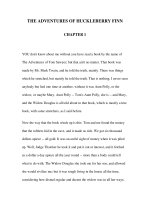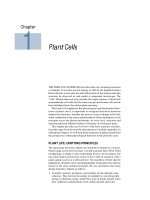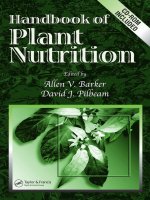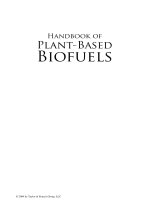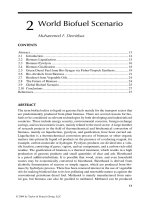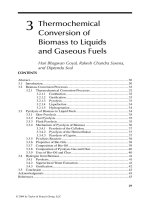Handbook of Plant Nutrition - chapter 1 doc
Bạn đang xem bản rút gọn của tài liệu. Xem và tải ngay bản đầy đủ của tài liệu tại đây (1.06 MB, 35 trang )
DK2972_half 5/11/06 12:55 PM Page 1
Handbook of
Plant
Nutrition
BOOKS IN SOILS, PLANTS, AND THE ENVIRONMENT
Editorial Board
Agricultural Engineering Robert M. Peart, University of Florida, Gainesville
Crops Mohammad Pessarakli, University of Arizona, Tucson
Environment Kenneth G. Cassman, University of Nebraska,
Lincoln
Irrigation and Hydrology Donald R. Nielsen, University of California, Davis
Microbiology Jan Dirk van Elsas, Research Institute for Plant
Protection, Wageningen, The Netherlands
Plants L. David Kuykendall, U.S. Department of
Agriculture, Beltsville, Maryland
Kenneth B. Marcum, Arizona State University, Tempe
Soils Jean-Marc Bollag, Pennsylvania State University,
University Park
Tsuyoshi Miyazaki, University of Tokyo, Japan
Soil Biochemistry, Volume 1,
edited by A. D. McLaren
and G. H. Peterson
Soil Biochemistry, Volume 2,
edited by A. D. McLaren and J. Skujins
Soil Biochemistry, Volume 3,
edited by E. A. Paul and A. D. McLaren
Soil Biochemistry, Volume 4,
edited by E. A. Paul and A. D. McLaren
Soil Biochemistry, Volume 5,
edited by E. A. Paul and J. N. Ladd
Soil Biochemistry, Volume 6,
edited by Jean-Marc Bollag
and G. Stotzky
Soil Biochemistry, Volume 7,
edited by G. Stotzky
and Jean-Marc Bollag
Soil Biochemistry, Volume 8,
edited by Jean-Marc Bollag
and G. Stotzky
Soil Biochemistry, Volume 9,
edited by G. Stotzky
and Jean-Marc Bollag
DK2972_series 5/11/06 11:36 AM Page 1
Organic Chemicals in the Soil Environment, Volumes 1 and 2,
edited by C. A. I. Goring and J. W. Hamaker
Humic Substances in the Environment
, M. Schnitzer and S. U. Khan
Microbial Life in the Soil: An Introduction
, T. Hattori
Principles of Soil Chemistry
, Kim H. Tan
Soil Analysis: Instrumental Techniques and Related Procedures
,
edited by Keith A. Smith
Soil Reclamation Processes: Microbiological Analyses and
Applications
, edited by Robert L. Tate III and Donald A. Klein
Symbiotic Nitrogen Fixation Technology
, edited by Gerald H. Elkan
Soil-–Water Interactions: Mechanisms and Applications
, Shingo Iwata
and Toshio Tabuchi with Benno P. Warkentin
Soil Analysis: Modern Instrumental Techniques, Second Edition
,
edited by Keith A. Smith
Soil Analysis: Physical Methods
, edited by Keith A. Smith
and Chris E. Mullins
Growth and Mineral Nutrition of Field Crops
, N. K. Fageria,
V. C. Baligar, and Charles Allan Jones
Semiarid Lands and Deserts: Soil Resource and Reclamation
,
edited by J. Skujins
Plant Roots: The Hidden Half
, edited by Yoav Waisel, Amram Eshel,
and Uzi Kafkafi
Plant Biochemical Regulators
, edited by Harold W. Gausman
Maximizing Crop Yields
, N. K. Fageria
Transgenic Plants: Fundamentals and Applications
, edited by
Andrew Hiatt
Soil Microbial Ecology: Applications in Agricultural and Environmental
Management
, edited by F. Blaine Metting, Jr.
Principles of Soil Chemistry: Second Edition
, Kim H. Tan
Water Flow in Soils
, edited by Tsuyoshi Miyazaki
Handbook of Plant and Crop Stress
, edited by Mohammad Pessarakli
Genetic Improvement of Field Crops
, edited by Gustavo A. Slafer
Agricultural Field Experiments: Design and Analysis
,
Roger G. Petersen
Environmental Soil Science
, Kim H. Tan
Mechanisms of Plant Growth and Improved Productivity: Modern
Approaches
, edited by Amarjit S. Basra
Selenium in the Environment
, edited by W. T. Frankenberger, Jr.
and Sally Benson
Plant–Environment Interactions
, edited by Robert E. Wilkinson
Handbook of Plant and Crop Physiology
, edited by
Mohammad Pessarakli
DK2972_series 5/11/06 11:36 AM Page 2
Handbook of Phytoalexin Metabolism and Action
, edited by M. Daniel
and R. P. Purkayastha
Soil–Water Interactions: Mechanisms and Applications, Second
Edition, Revised and Expanded
, Shingo Iwata, Toshio Tabuchi,
and Benno P. Warkentin
Stored-Grain Ecosystems
, edited by Digvir S. Jayas, Noel D. G. White,
and William E. Muir
Agrochemicals from Natural Products
, edited by C. R. A. Godfrey
Seed Development and Germination
, edited by Jaime Kigel
and Gad Galili
Nitrogen Fertilization in the Environment
, edited by
Peter Edward Bacon
Phytohormones in Soils: Microbial Production and Function
,
William T. Frankenberger, Jr., and Muhammad Arshad
Handbook of Weed Management Systems
, edited by Albert E. Smith
Soil Sampling, Preparation, and Analysis
, Kim H. Tan
Soil Erosion, Conservation, and Rehabilitation
, edited by
Menachem Agassi
Plant Roots: The Hidden Half, Second Edition, Revised and
Expanded
, edited by Yoav Waisel, Amram Eshel,
and Uzi Kafkafi
Photoassimilate Distribution in Plants and Crops: Source–Sink
Relationships
, edited by Eli Zamski and Arthur A. Schaffer
Mass Spectrometry of Soils
, edited by Thomas W. Boutton
and Shinichi Yamasaki
Handbook of Photosynthesis
, edited by Mohammad Pessarakli
Chemical and Isotopic Groundwater Hydrology: The Applied
Approach, Second Edition
,
Revised and Expanded
,
Emanuel Mazor
Fauna in Soil Ecosystems: Recycling Processes, Nutrient Fluxes,
and Agricultural Production
, edited by Gero Benckiser
Soil and Plant Analysis in Sustainable Agriculture and Environment
,
edited by Teresa Hood and J. Benton Jones, Jr.
Seeds Handbook: Biology, Production, Processing, and Storage
,
B. B. Desai, P. M. Kotecha, and D. K. Salunkhe
Modern Soil Microbiology
, edited by J. D. van Elsas, J. T. Trevors,
and E. M. H. Wellington
Growth and Mineral Nutrition of Field Crops: Second Edition
,
N. K. Fageria, V. C. Baligar, and Charles Allan Jones
Fungal Pathogenesis in Plants and Crops: Molecular Biology
and Host Defense Mechanisms
, P. Vidhyasekaran
Plant Pathogen Detection and Disease Diagnosis
, P. Narayanasamy
DK2972_series 5/11/06 11:36 AM Page 3
Agricultural Systems Modeling and Simulation
, edited by
Robert M. Peart and R. Bruce Curry
Agricultural Biotechnology
, edited by Arie Altman
Plant–Microbe Interactions and Biological Control
, edited by
Greg J. Boland and L. David Kuykendall
Handbook of Soil Conditioners: Substances That Enhance
the Physical Properties of Soil
, edited by Arthur Wallace
and Richard E. Terry
Environmental Chemistry of Selenium
, edited by
William T. Frankenberger, Jr., and Richard A. Engberg
Principles of Soil Chemistry: Third Edition
,
Revised and Expanded
,
Kim H. Tan
Sulfur in the Environment
, edited by Douglas G. Maynard
Soil–Machine Interactions: A Finite Element Perspective
, edited by
Jie Shen and Radhey Lal Kushwaha
Mycotoxins in Agriculture and Food Safety
, edited by Kaushal K.
Sinha and Deepak Bhatnagar
Plant Amino Acids: Biochemistry and Biotechnology
, edited by
Bijay K. Singh
Handbook of Functional Plant Ecology
, edited by Francisco I.
Pugnaire and Fernando Valladares
Handbook of Plant and Crop Stress: Second Edition
,
Revised
and Expanded
, edited by Mohammad Pessarakli
Plant Responses to Environmental Stresses: From Phytohormones
to Genome Reorganization
, edited by H. R. Lerner
Handbook of Pest Management
, edited by John R. Ruberson
Environmental Soil Science: Second Edition, Revised and Expanded,
Kim H. Tan
Microbial Endophytes
, edited by Charles W. Bacon
and James F. White, Jr.
Plant–Environment Interactions: Second Edition
, edited by
Robert E. Wilkinson
Microbial Pest Control
, Sushil K. Khetan
Soil and Environmental Analysis: Physical Methods, Second Edition,
Revised and Expanded
, edited by Keith A. Smith
and Chris E. Mullins
The Rhizosphere: Biochemistry and Organic Substances at the
Soil–Plant Interface
, Roberto Pinton, Zeno Varanini,
and Paolo Nannipieri
Woody Plants and Woody Plant Management: Ecology, Safety,
and Environmental Impact
, Rodney W. Bovey
Metals in the Environment
, M. N. V. Prasad
DK2972_series 5/11/06 11:36 AM Page 4
Plant Pathogen Detection and Disease Diagnosis: Second Edition,
Revised and Expanded
, P. Narayanasamy
Handbook of Plant and Crop Physiology: Second Edition, Revised
and Expanded
, edited by Mohammad Pessarakli
Environmental Chemistry of Arsenic
, edited by
William T. Frankenberger, Jr.
Enzymes in the Environment: Activity, Ecology, and Applications
,
edited by Richard G. Burns and Richard P. Dick
Plant Roots: The Hidden Half, Third Edition, Revised and Expanded
,
edited by Yoav Waisel, Amram Eshel, and Uzi Kafkafi
Handbook of Plant Growth: pH as the Master Variable
, edited by
Zdenko Rengel
Biological Control of Major Crop Plant Diseases
edited by
Samuel S. Gnanamanickam
Pesticides in Agriculture and the Environment
, edited by
Willis B. Wheeler
Mathematical Models of Crop Growth and Yield
, , Allen R. Overman
and Richard Scholtz
Plant Biotechnology and Transgenic Plants
, edited by
Kirsi-Marja Oksman Caldentey and Wolfgang Barz
Handbook of Postharvest Technology: Cereals, Fruits, Vegetables,
Tea, and Spices
, edited by Amalendu Chakraverty,
Arun S. Mujumdar, G. S. Vijaya Raghavan,
and Hosahalli S. Ramaswamy
Handbook of Soil Acidity
, edited by Zdenko Rengel
Humic Matter in Soil and the Environment: Principles
and Controversies,
edited by Kim H. Tan
Molecular Host Plant Resistance to Pests
, edited by S. Sadasivam
and B. Thayumanayan
Soil and Environmental Analysis: Modern Instrumental Techniques,
Third Edition
, edited by Keith A. Smith and Malcolm S. Cresser
Chemical and Isotopic Groundwater Hydrology, Third Edition,
edited by Emanuel Mazor
Agricultural Systems Management: Optimizing Efficiency
and Performance
, edited by Robert M. Peart
and W. David Shoup
Physiology and Biotechnology Integration for Plant Breeding
,
edited by Henry T. Nguyen and Abraham Blum
Global Water Dynamics: Shallow and Deep Groundwater: Petroleum
Hydrology: Hydrothermal Fluids, and Landscaping
, , edited by
Emanuel Mazor
Principles of Soil Physics
, edited by Rattan Lal
Seeds Handbook: Biology, Production, Processing, and Storage,
Second Edition
, Babasaheb B. Desai
DK2972_series 5/11/06 11:36 AM Page 5
Field Sampling: Principles and Practices in Environmental Analysis,
edited by Alfred R. Conklin
Sustainable Agriculture and the International Rice-Wheat System
,
edited by Rattan Lal, Peter R. Hobbs, Norman Uphoff,
and David O. Hansen
Plant Toxicology, Fourth Edition
, edited by Bertold Hock
and Erich F. Elstner
Drought and Water Crises: Science, Technology, and Management
Issues
, edited by Donald A. Wilhite
Soil Sampling, Preparation, and Analysis, Second Edition
, Kim H. Tan
Climate Change and Global Food Security
, edited by Rattan Lal,
Norman Uphoff, B. A. Stewart, and David O. Hansen
Handbook of Photosynthesis, Second Edition
, edited by
Mohammad Pessarakli
Environmental Soil-Landscape Modeling: Geographic Information
Technologies and Pedometrics
, edited by Sabine Grunwald
Water Flow In Soils, Second Edition
, Tsuyoshi Miyazaki
Biological Approaches to Sustainable Soil Systems
, edited by
Norman Uphoff, Andrew S. Ball, Erick Fernandes, Hans Herren,
Olivier Husson, Mark Laing, Cheryl Palm, Jules Pretty, Pedro
Sanchez, Nteranya Sanginga, and Janice Thies
Plant–Environment Interactions, Third Edition
, edited by Bingru Huang
Biodiversity In Agricultural Production Systems
, edited by
Gero Benckiser and Sylvia Schnell
Organic Production and Use of Alternative Crops
, Franc Bavec
and Martina Bavec
Handbook of Plant Nutrition
, edited by Allen V. Barker
and David J. Pilbeam
DK2972_series 5/11/06 11:36 AM Page 6
CRC_DK2972_FM.qxd 7/20/2006 1:43 PM Page ii
DK2972_title 5/11/06 12:54 PM Page 1
Handbook of
Plant
Nutrition
Edited by
Allen V. Barker
David J. Pilbeam
CRC is an imprint of the Taylor & Francis Group,
an informa business
Boca Raton London New York
Cover photo by Allen V. Barker.
CRC Press
Taylor & Francis Group
6000 Broken Sound Parkway NW, Suite 300
Boca Raton, FL 33487‑2742
© 2007 by Taylor & Francis Group, LLC
CRC Press is an imprint of Taylor & Francis Group, an Informa business
No claim to original U.S. Government works
Printed in the United States of America on acid‑free paper
10 9 8 7 6 5 4 3 2 1
International Standard Book Number‑10: 0‑8247‑5904‑4 (Hardcover)
International Standard Book Number‑13: 978‑0‑8247‑5904‑9 (Hardcover)
This book contains information obtained from authentic and highly regarded sources. Reprinted material is quoted
with permission, and sources are indicated. A wide variety of references are listed. Reasonable efforts have been made to
publish reliable data and information, but the author and the publisher cannot assume responsibility for the validity of
all materials or for the consequences of their use.
No part of this book may be reprinted, reproduced, transmitted, or utilized in any form by any electronic, mechanical, or
other means, now known or hereafter invented, including photocopying, microfilming, and recording, or in any informa‑
tion storage or retrieval system, without written permission from the publishers.
For permission to photocopy or use material electronically from this work, please access www.copyright.com (http://
www.copyright.com/) or contact the Copyright Clearance Center, Inc. (CCC) 222 Rosewood Drive, Danvers, MA 01923,
978‑750‑8400. CCC is a not‑for‑profit organization that provides licenses and registration for a variety of users. For orga‑
nizations that have been granted a photocopy license by the CCC, a separate system of payment has been arranged.
Trademark Notice: Product or corporate names may be trademarks or registered trademarks, and are used only for
identification and explanation without intent to infringe.
Library of Congress Cataloging‑in‑Publication Data
Barker, Allen V., 1937‑
Handbook of plant nutrition / Allen V. Barker, David J. Pilbeam.
p. cm. ‑‑ (Books in soils, plants, and the environment ; v. 117)
Includes bibliographical references.
ISBN 0‑8247‑5904‑4
1. Plants‑‑Nutrition‑‑Handbooks, manuals, etc. I. Pilbeam, D. J. II. Title. III. Series.
QK867.B29 2006
631.8‑‑dc22 2006044539
Visit the Taylor & Francis Web site at
and the CRC Press Web site at
Preface
For over 150 years, scientists have studied plant nutrition with goals of understanding the acquisi-
tion, accumulation, transport, and functions of chemical elements in plants. From these studies,
much information has been obtained about the growth and composition of plants in response to soil-
borne elements and to fertilization of crops in the soil or in soil-less media, as in hydroponic cul-
ture of plants. A compilation of elements known as plant nutrients and beneficial elements has also
been developed from this work.
Plant nutrients are chemical elements that are essential for plant growth. For an element to be
essential, it must be required for a plant to complete its life cycle, it must be required by all plants,
and no other nutrient can replace this requirement fully. If an element does not meet all of these re-
quirements, for example, being required by some plants or only enhancing the growth of plants, the
element may be a beneficial element. Much interest in plant nutrition lies in the development and
use of diagnostic techniques for assessment of the status of plants with respect to plant nutrients and
beneficial elements.
Soil testing is a common approach to assessments of soil fertility and plant nutrition. With cor-
relation to plant growth, development, and yield, soil testing indicates the capacity of soils to sup-
ply plant nutrients and suggests appropriate corrective measures. Plant analysis, used in conjunc-
tion with plant symptoms and soil testing, is another common tool for assessment of the nutritional
status of plants.
This handbook covers principles of plant nutrition from a historical standpoint to current knowl-
edge of the requirements of crops for certain elements and the beneficial effects of others. Its lay-
out owes much to Homer D. Chapman’s 1966 book Diagnostic Criteria for Plants and Soils and,
as with that book, presents contributions from eminent plant and soil scientists from around the
world. The purpose of this handbook is to provide a current, readily available source of information
on the nutritional requirements of world crops.
In the Introduction, the editors provide an overview of plant nutrients and beneficial elements
and note diagnostic criteria and research approaches used by current investigators who are inter-
ested in plant nutrition.
Each of the chapters dealing with plant nutrients starts with historical information of each nu-
trient, including the demonstration of essentiality and functions in plants. Each of these chapters
will include diagnosis of the nutritional status of plants through assessments of plant appearance
and composition. Tabulated data will help correlate plant appearance and composition with regard
to nutritional needs. A discussion of the value of soil tests for assessment of the nutritional status of
plants will be provided in each chapter. Each chapter will conclude with fertilizers that can be ap-
plied to remedy nutritional deficiencies in plants.
Chapters concerning beneficial elements will discuss the history of the relation of the beneficial
effects of these elements to crop growth and yield and will relate the benefits to growth stimulation
and plant metabolism for particular plant species.
A separate CD-ROM containing all the photographs and some line drawings in color is included
with the book, because color versions of the illustrations offer details not obvious in black-and-
white pictures.
With the world population increasing rapidly, and projected to do so for some time, and with
improved plant nutrition remaining as one of the major factors increasing crop yields, use of our
knowledge of plant nutrition to maximize agricultural yields grows in importance. However, public
interest in minimizing the use of chemical inputs in agriculture also is increasing with emphasis on
CRC_DK2972_FM.qxd 7/20/2006 1:43 PM Page v
less use of chemical fertilizers and more use of alternative fertilizers. Attention to precision agri-
culture, in which plant nutrition is controlled or monitored carefully, has grown in research and
practice. All of these situations require knowledge of plant nutrition.
The handbook is intended to be a practical reference work for anyone who needs to know the
requirements of the world’s major crops for essential or beneficial elements. It will also give infor-
mation on how to assess and govern the nutritional status of crops. It should be of use to farmers,
agricultural advisers, soil scientists, and plant scientists.
CRC_DK2972_FM.qxd 7/20/2006 1:43 PM Page vi
Allen V. Barker
Department of Plant, Soil, and Insect Sciences
University of Massachusetts
Amherst, Massachusetts
Elke Bloem
Institute of Plant Nutrition and
Soil Science
Federal Agricultural Research Centre (FAL)
Braunschweig, Germany
Patrick H. Brown
Department of Plant Sciences
University of California
Davis, California
Gretchen M. Bryson
Department of Plant, Soil, and Insect Sciences
University of Massachusetts
Amherst, Massachusetts
Lawrence E. Datnoff
Plant Pathology Department
University of Florida/IFAS
Gainesville, Florida
Luit J. de Kok
Laboratory of Plant Physiology
University of Groningen
Haren, The Netherlands
Khaled Drihem
School of Biology
University of Leeds
Leeds, United Kingdom
Michael A. Dunn
Department of Human Nutrition, Food and
Animal Sciences
University of Hawaii at Manoa
Honolulu, Hawaii
John Gorham
Arid Land Research Center
Tottori University
Tottori, Japan
and
Centre for Arid Zone Studies and School of
Biological Sciences
University of Wales
Bangor, United Kingdom
Robin D. Graham
Discipline of Plant and Food Science
School of Agriculture, Food and Wine
University of Adelaide
Adelaide, Australia
Umesh C. Gupta
Crops and Livestock Research Centre
Agriculture and Agri-Food Canada
Charlottetown, Prince Edward Island, Canada
Russell L. Hamlin
Coggins Farms and Produce
Lake Park, Georgia
Silvia Haneklaus
Institute of Plant Nutrition and Soil
Science
Federal Agricultural Research
Centre (FAL)
Braunschweig, Germany
Joseph R. Heckman
Plant Biology and Pathology Department
Rutgers University
New Brunswick, New Jersey
N.V. Hue
Department of Tropical Plant and Soil
Sciences
University of Hawaii at Manoa
Honolulu, Hawaii
Julia M. Humphries
Discipline of Plant and Food Science
School of Agriculture, Food and Wine
University of Adelaide
Adelaide, Australia
Contributors
CRC_DK2972_FM.qxd 7/20/2006 1:43 PM Page vii
David E. Kopsell
School of Agriculture
University of Wisconsin
Platteville, Wisconsin
Dean A. Kopsell
Plant Sciences Department
University of Tennessee
Knoxville, Tennessee
Vladimir V. Matichenkov
Institute of Basic Biological Problems
Russian Academy of Sciences
Pushchino, Russia
Konrad Mengel
Institute of Plant Nutrition
Justus Liebig University
Giessen, Germany
Donald J. Merhaut
Department of Botany and Plant Sciences
University of California
Riverside, California
Susan C. Miyasaka
Department of Tropical Plant and Soil
Sciences
University of Hawaii at Manoa
Hilo, Hawaii
Philip S. Morley
Wight Salads Ltd.
Arreton, United Kingdom
Miroslav Nikolic
Centre for Multidisciplinary Studies
University of Belgrade
Belgrade, Serbia
David J. Pilbeam
Institute of Intergrative and Comparative
Biology
University of Leeds
Leeds, United Kingdom
Volker Römheld
Institute of Plant Nutrition
University of Hohenheim
Stuttgart, Germany
Charles A. Sanchez
Department of Soil, Water, and Environmental
Sciences
Yuma Agricultural Center
Yuma, Arizona
Ewald Schnug
Institute of Plant Nutrition and
Soil Science
Federal Agricultural Research Centre (FAL)
Braunschweig, Germany
Archana Sharma
Department of Botany
University of Calcutta
Kolkata, India
George H. Snyder
University of Florida/IFAS
Everglades Research and Education Center
Belle Glade, Florida
James C.R. Stangoulis
Discipline of Plant and Food Science
School of Agriculture, Food and Wine
University of Adelaide
Adelaide, Australia
J. Benton Storey
Department of Horticultural Science
Texas A&M University
College Station, Texas
Ineke Stulen
Laboratory of Plant Physiology
University of Groningen
Haren, The Netherlands
Geeta Talukder
Vivekananda Institute of Medical Sciences
Kolkata, India
CRC_DK2972_FM.qxd 7/20/2006 1:43 PM Page viii
Section I
Introduction 1
Chapter 1 Introduction 3
Allen V. Barker and David J. Pilbeam
Section II
Essential Elements––Macronutrients 19
Chapter 2 Nitrogen 21
Allen V. Barker and Gretchen M. Bryson
Chapter 3 Phosphorus 51
Charles A. Sanchez
Chapter 4 Potassium 91
Konrad Mengel
Chapter 5 Calcium 121
David J. Pilbeam and Philip S. Morley
Chapter 6 Magnesium 145
Donald J. Merhaut
Chapter 7 Sulfur 183
Silvia Haneklaus, Elke Bloem, Ewald Schnug, Luit J. de Kok, and Ineke Stulen
Section III
Essential Elements––Micronutrients 239
Chapter 8 Boron 241
Umesh C. Gupta
Chapter 9 Chlorine 279
Joseph R. Heckman
Chapter 10 Copper 293
David E. Kopsell and Dean A. Kopsell
Contents
CRC_DK2972_FM.qxd 7/20/2006 1:43 PM Page ix
Chapter 11 Iron 329
Volker Römheld and Miroslav Nikolic
Chapter 12 Manganese 351
Julia M. Humphries, James C.R. Stangoulis, and Robin D. Graham
Chapter 13 Molybdenum 375
Russell L. Hamlin
Chapter 14 Nickel 395
Patrick H. Brown
Chapter 15 Zinc 411
J. Benton Storey
Section IV
Beneficial Elements 437
Chapter 16 Aluminum 439
Susan C. Miyasaka, N.V. Hue, and Michael A. Dunn
Chapter 17 Cobalt 499
Geeta Talukder and Archana Sharma
Chapter 18 Selenium 515
Dean A. Kopsell and David E. Kopsell
Chapter 19 Silicon 551
George H. Snyder, Vladimir V. Matichenkov, and Lawrence E. Datnoff
Chapter 20 Sodium 569
John Gorham
Chapter 21 Vanadium 585
David J. Pilbeam and Khaled Drihem
Section V
Conclusion 597
Chapter 22 Conclusion 599
Allen V. Barker and David J. Pilbeam
Index 605
CRC_DK2972_FM.qxd 7/20/2006 1:43 PM Page x
Section I
Introduction
CRC_DK2972_Ch001.qxd 6/30/2006 12:48 PM Page 1
CRC_DK2972_Ch001.qxd 6/30/2006 12:48 PM Page 2
1
Introduction
Allen V. Barker
University of Massachusetts, Amherst, Massachusetts
David J. Pilbeam
University of Leeds, Leeds, United Kingdom
CONTENTS
1.1 Definitions 3
1.1.1 Plant Nutrient 3
1.2 Diagnostic Criteria 5
1.2.1 Visual Diagnosis 5
1.2.2 Plant Analysis 8
1.2.3 Quantitative Analysis 8
1.2.4 Tissue Testing 9
1.2.5 Biochemical Tests 10
1.2.6 Soil Tests 11
1.3 Approaches in Research 12
References 13
1.1 DEFINITIONS
1.1.1 P
LANT NUTRIENT
A plant nutrient is a chemical element that is essential for plant growth and reproduction. Essential
element is a term often used to identify a plant nutrient. The term nutrient implies essentiality, so it
is redundant to call these elements essential nutrients. Commonly, for an element to be a nutrient,
it must fit certain criteria. The principal criterion is that the element must be required for a plant to
complete its life cycle. The second criterion is that no other element substitutes fully for the ele-
ment being considered as a nutrient. The third criterion is that all plants require the element. All the
elements that have been identified as plant nutrients, however, do not fully meet these criteria, so,
some debate occurs regarding the standards for classifying an element as a plant nutrient. Issues
related to the identification of new nutrients are addressed in some of the chapters in this handbook.
The first criterion, that the element is essential for a plant to complete its life cycle, has histor-
ically been the one with which essentiality is established (1). This criterion includes the property
that the element has a direct effect on plant growth and reproduction. In the absence of the essen-
tial element or with severe deficiency, the plant will die before it completes the cycle from seed to
seed. This requirement acknowledges that the element has a function in plant metabolism; that with
short supply of the nutrient, abnormal growth or symptoms of deficiency will develop as a result of
the disrupted metabolism; and that the plant may be able to complete its life cycle with restricted
3
CRC_DK2972_Ch001.qxd 6/30/2006 12:48 PM Page 3
growth and abnormal appearance. This criterion also notes that the occurrence of an element in a
plant is not evidence of essentiality. Plants will accumulate elements that are in solution without
regard to the elements having any essential role in plant metabolism or physiology.
The second criterion states that the role of the element must be unique in plant metabolism or
physiology, meaning that no other element will substitute fully for this function. A partial substitution
might be possible. For example, a substitution of manganese for magnesium in enzymatic reactions
may occur, but no other element will substitute for magnesium in its role as a constituent of chloro-
phyll (2). Some scientists believe that this criterion is included in the context of the first criterion (3).
The third criterion requires that the essentiality is universal among plants. Elements can affect
plant growth without being considered as essential elements (3,4). Enhancement of growth is not a
defining characteristic of a plant nutrient, since although growth might be stimulated by an element,
the element is not absolutely required for the plant to complete its life cycle. Some plants may respond
to certain elements by exhibiting enhanced growth or higher yields, such as that which occurs with the
supply of sodium to some crops (5,6). Also, some elements may appear to be required by some plants
because the elements have functions in metabolic processes in the plants, such as in the case of cobalt
being required for nitrogen-fixing plants (7). Nitrogen fixation, however, is not vital for these plants
since they will grow well on mineral or inorganic supplies of nitrogen. Also, plants that do not fix
nitrogen do not have any known need for cobalt (3). Elements that might enhance growth or that have
a function in some plants but not in all plants are referred to as beneficial elements.
Seventeen elements are considered to have met the criteria for designation as plant nutrients.
Carbon, hydrogen, and oxygen are derived from air or water. The other 14 are obtained from soil or
nutrient solutions (Table 1.1). It is difficult to assign a precise date or a specific researcher to the
discovery of the essentiality of an element. For all the nutrients, their roles in agriculture were
the subjects of careful investigations long before the elements were accepted as nutrients. Many
4 Handbook of Plant Nutrition
TABLE 1.1
Listing of Essential Elements, Their Date of Acceptance as Essential, and
Discoverers of Essentiality
Element Date of Essentiality
a
Researcher
a
Nitrogen 1804 de Saussure
b
1851–1855 Boussingault
b
Phosphorus 1839 Liebig
c
1861 Ville
b
Potassium 1866 Birner & Lucanus
b
Calcium 1862 Stohmann
b
Magnesium 1875 Boehm
b
Sulfur 1866 Birner & Lucanus
b
Iron 1843 Gris
c
Manganese 1922 McHargue
c
Copper 1925 McHargue
c
Boron 1926 Sommer & Lipman
c
Zinc 1926 Sommer & Lipman
c
Molybdenum 1939 Arnon & Stout
c
Chlorine 1954 Broyer, Carlton, Johnson, & Stout
c
Nickel 1987 Brown, Welch, & Cary (11)
a
The dates and researchers that are listed are those on which published articles amassed enough infor-
mation to convince other researchers that the elements were plant nutrients. Earlier work preceding
the dates and other researchers may have suggested that the elements were nutrients.
b
Cited by Reed (22).
c
Cited by Chapman (13).
CRC_DK2972_Ch001.qxd 6/30/2006 12:48 PM Page 4
individuals contributed to the discovery of the essentiality of elements in plant nutrition. Much of
the early research focused on the beneficial effects or sometimes on the toxic effects of the ele-
ments. Generally, an element was accepted as a plant nutrient after the body of evidence suggested
that the element was essential for plant growth and reproduction, leading to the assignment of cer-
tain times and individuals to the discovery of its essentiality (Table 1.1).
Techniques of hydroponics (8,9) initiated in the mid-1800s and improved in the 1900s enabled
experimenters to grow plants in defined media purged of elements. Elements that are required in con-
siderable quantities (macronutrients), generally accumulating to 0.1% and upward of the dry mass in
plant tissues, were shown to be nutrients in the mid-1800s. Most of the elements required in small quan-
tities in plants (micronutrients), generally accumulating to amounts less than 0.01% of the dry mass of
plant tissues, were shown to be essential only after techniques were improved to ensure that the water,
reagents, media, atmosphere, and seeds did not contain sufficient amounts of nutrients to meet the needs
of the plants. Except for iron, the essentiality of micronutrients was demonstrated in the 1900s.
Beneficial elements may stimulate growth or may be required by only certain plants. Silicon,
cobalt, and sodium are notable beneficial elements. Selenium, aluminum, vanadium, and other ele-
ments have been suggested to enhance growth of plants (3,10). Some of the beneficial elements may
be classified in the future as essential elements as developments in chemical analysis and methods of
minimizing contamination during growth show that plants will not complete their life cycles if the
concentrations of elements in plant tissues are diminished sufficiently. Nickel is an example of an
element that was classified as beneficial but recently has been shown to be essential (11).
Studies of the roles of nutrients in plants have involved several diagnostic criteria that address
the accumulation of nutrients and their roles in plants. These criteria include visual diagnosis, plant
analysis, biochemical tests, and soil tests.
1.2 DIAGNOSTIC CRITERIA
1.2.1 V
ISUAL DIAGNOSIS
Careful observations of the growth of plants can furnish direct evidence of their nutritional conditions.
Metabolic disruptions resulting from nutrient deficiencies provide links between the function of an ele-
ment and the appearance of a specific visible abnormality. Symptoms of disorders, therefore, provide a
guide to identify nutritional deficiencies in plants. Careful experimental work and observations are
needed to characterize symptoms. For example, nitrogen is needed for protein synthesis and for chloro-
phyll synthesis, and symptoms appear as a result of the disruption of these processes. Symptoms of
nitrogen deficiency appear as pale-green or yellow leaves starting from the bottom and extending
upward or sometimes covering the entire plant. Magnesium deficiency also affects protein synthesis
and chlorophyll synthesis, but the symptoms may not resemble those of nitrogen deficiency, which
affects the same processes. Experience is necessary to distinguish the symptoms of nitrogen deficiency
from symptoms of magnesium deficiency or in the identification of the deficiency of any nutrient.
Symptoms on foliage have been classified into five types (12): (a) chlorosis, which may be uni-
form or interveinal (Figure 1.1); (b) necrosis, which may be at leaf tips or margins, or be interveinal
(Figure 1.2); (c) lack of new growth, which may result in death of terminal or axillary buds and
leaves, dieback, or rosetting (Figure 1.3); (d) accumulation of anthocyanin, which results in an over-
all red color (Figure 1.4); and (e) stunting with normal green color or an off-green or yellow color
(Figure 1.5). Symptoms of deficiency can be quite specific according to nutrient, especially if the
diagnosis is made early in the development of the symptoms. Symptoms may become similar
among deficiencies as the intensities of the symptoms progress.
Generalities of development of deficiency symptoms can be made among species. Many refer-
ences are available with descriptions, plates, or keys that enable identification of nutrient deficien-
cies (12–20). As mentioned above, for example, nitrogen deficiency appears across plant species as
chlorosis of lower or of all leaves on plants. Advanced stages of nitrogen deficiency can lead to
leaf death and leaf drop. Nitrogen-deficient plants generally are stunted and spindly in addition to
Introduction 5
CRC_DK2972_Ch001.qxd 6/30/2006 12:48 PM Page 5
showing the discoloration that is imparted by chlorosis. Potassium-deficient plants have marginal and
tip necrosis of lower leaves. On the other hand, for elements that are immobile (not transported in
phloem) or slowly mobile in plants, the deficiency symptoms will appear on the young leaves first.
The symptoms might appear as chlorosis, as with sulfur, iron, manganese, zinc, or copper deficiency,
or the symptoms might be necrosis of entire plant tips, as occurs with boron or calcium deficiency.
Brooms or rosetting may occur in cases where deficiencies (e.g., copper or zinc) have caused death
of the terminal bud and lateral buds have grown or where internode elongation has been restricted by
6 Handbook of Plant Nutrition
FIGURE 1.1 Interveinal chlorosis of iron-deficient borage (Borago officinalis L.). (Photograph by Allen V.
Barker.) (For a color presentation of this figure, see the accompanying compact disc.)
FIGURE 1.2 Deficiency symptoms showing necrosis of leaf margins, as in this case of potassium deficiency
on cucumber (Cucumis sativus L.) leaf. (Photograph by Allen V. Barker.) (For a color presentation of this
figure, see the accompanying compact disc.)
CRC_DK2972_Ch001.qxd 6/30/2006 12:48 PM Page 6
nutrient (e.g., zinc) deficiencies. Accumulation of anthocyanin, exhibited by reddening of leaves,
may indicate phosphorus deficiency, although nitrogen deficiency can lead to a similar development.
Some people try to distinguish the two deficiencies by noting whether the symptoms of reddening
develop between the veins (phosphorus deficiency) or along the veins (nitrogen deficiency). Stunting
is a good indication of nutrient deficiency, but often stunting cannot be recognized unless a well-
nourished plant is available as a standard of comparison. A stunted plant may have normal color and
not be recognized as being deficient until abnormal coloration develops with advanced stages of defi-
ciency. In some cases, symptoms may not develop during the growth cycle of crops, but yields may
be suppressed relative to plants that have optimum nutrition. Hidden hunger is a term applied to cases
where yield suppression occurred but symptoms did not develop.
Deficiency symptoms can occur at any stage of growth of a plant. The most typical symptoms
are those that appear early in the cycle of deficiency. Early diagnosis of deficiencies may also allow
Introduction 7
FIGURE 1.3 Deficiency symptoms showing necrosis on young leaves of (a) calcium-deficient lettuce (Lactuca
sativa L.) and necrosis on young and old leaves of (b) calcium-deficient cucumber (Cucumis sativus L.). With
cucumber the necrosis has extended to all leaves that have not expanded to the potential size of full maturity.
(Photographs by Allen V. Barker.) (For a color presentation of this figure, see the accompanying compact disc.)
FIGURE 1.4 Stunting and development of red color and loss of green color of phosphorus-deficient tomato
(Lycopersicon esculentum Mill.). (Photograph by Allen V. Barker.) (For a color presentation of this figure, see
the accompanying compact disc.)
CRC_DK2972_Ch001.qxd 6/30/2006 12:48 PM Page 7
time for remedial action to take place. Generally, however, if symptoms have appeared, irreparable
damage has occurred, with quantity or quality of yields being suppressed or diminished with annual
crops or with slowing or damaging of growth and development of perennial crops. Also, symptoms
that resemble nutrient deficiency can develop on plants as a result of conditions that are not related
to nutrient deficiencies, for example, drought, wet soils, cold soils, insect or disease infestations,
herbicide damage, wind, mechanical damage, salinity, or elemental toxicities. Deficiency symptoms
are only one of several diagnostic criteria that can be used to assess the nutritional status of plants.
Plant analysis, biological tests, soil analysis, and application of fertilizers containing the nutrient in
question are additional tools used in diagnosis of the status of plant nutrition.
1.2.2 PLANT ANALYSIS
Plant analysis as a means of understanding plant physiology perhaps started with de Saussure (21).
With plant analysis, de Saussure corrected the misunderstanding at the time that the mineral matter
of plants had no importance. He showed that the mineral matter in plants came from the soil and
not from the air and that little growth of plants occurred if they were grown in distilled water.
Through plant analysis, he also demonstrated that plants absorbed minerals in ratios that differed
from the proportions existing in solution or in soil and that plants absorbed substances from solu-
tion, whether the substances were beneficial to the plants or not.
Plant analysis was one of the means used by scientists in the 1800s to determine the essential-
ity of chemical elements as plant nutrients (22). Further refinements and applications of plant analy-
sis led to studies of the relationship between crop growth or yield and nutrient concentrations in
plants (23–26). Elemental analysis of leaves is commonly used as a basis for crop fertilizer recom-
mendations (27,28).
Plants can be tested for sufficiency of nutrition by analytical tests, which employ quantitative
analysis (total or specific components) in laboratories, or by tissue tests (semiquantitative analysis),
often applied in the field. With proper means of separation of constituents, quantitative tests may
measure nutrients that have been incorporated into plant structures or that are present as soluble
constituents in the plant sap. The tissue tests generally deal with soluble constituents.
1.2.3 QUANTITATIVE ANALYSIS
Quantitative plant analysis has several functions in assessing the nutrient status of plants (29).
Among these functions, plant analysis can be used to confirm a visual diagnosis. Plant analysis
8 Handbook of Plant Nutrition
FIGURE 1.5 Cabbage (Brassica oleracea var. capitata L.) plants showing symptoms of stunting. Left: stunt-
ing and dark green color diagnosed as being caused by salinity in nutrient solution. Middle: stunting and mot-
tling of foliage due to condition diagnosed as magnesium deficiency. Right: stunting and discoloration of
foliage due to condition diagnosed as phosphorus deficiency. (Photographs by Allen V. Barker.) (For a color
presentation of this figure, see the accompanying compact disc.)
CRC_DK2972_Ch001.qxd 6/30/2006 12:48 PM Page 8
